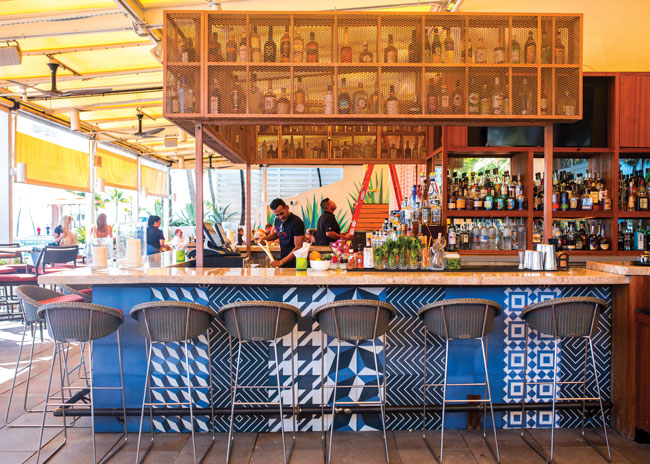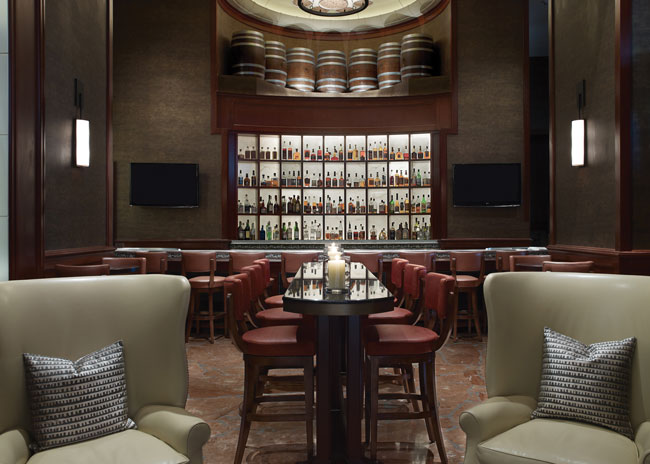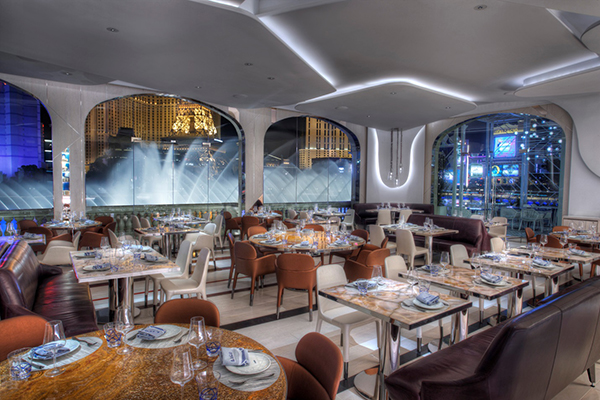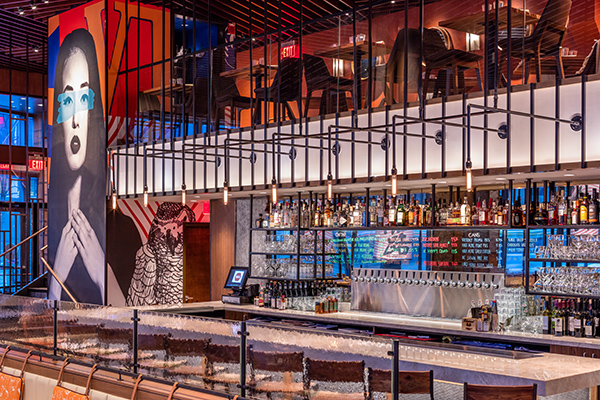To carve out a niche and create a point of differentiation in a crowded market, more bars and restaurants are amassing curated collections of a single-spirit category — whiskey, tequila and mescal, rum, gin, brandy and other liquors. Such in-depth selections attract aficionados seeking rare and highly allocated bottlings. This strategy also showcases the knowledge and expertise of the bar staff and gives a laser-sharp focus to cocktail programs.
The design focus of these library concepts is an impressive backbar display, which introduces a theatrical element, spotlighting the bottles, creating intrigue and drama, and establishing a thematic and welcoming atmosphere in which to explore the breadth of a fine spirit.
 Showcasing a collection of sake and Japanese spirits, the backbar is a three-dimensional rendition of the two-dimensional Periodic Table. The shelves demonstrate the art of Japanese woodworking, and the printed fabric recalls doorway noren screens. Images courtesy of ArcsineThe Periodic Table
Showcasing a collection of sake and Japanese spirits, the backbar is a three-dimensional rendition of the two-dimensional Periodic Table. The shelves demonstrate the art of Japanese woodworking, and the printed fabric recalls doorway noren screens. Images courtesy of ArcsineThe Periodic Table
Emeryville, Calif.
“Hiroko and I met in an organic chemistry lab. She is from Japan, and we love good drinks and good design. The Periodic Table brings all these elements together and creates a truly unique customer experience,” says Jake Freed, co-owner with his wife, Hiroko. The mission of the intimate, 18-seat, 400-square-foot taproom located in the Public Market Food Hall is to make sake and Japanese spirits — whisky, shochu, gin and vodka — more approachable for American consumers.
“We wanted to celebrate the owners’ backgrounds and reflect their passion for Japanese geometry and art of Japanese hosting into the design,” says Soo Yoo, a designer with the San Francisco-based architectural and design firm Arcsine.
“Arcsine came up with a great idea — modeling the back bar as rows of open boxes in a manner that clearly evokes the Periodic Table,” says Freed. Another design element includes fabric swatches over some of the boxes printed with drink-related images: hops, sake cups, an old Japanese brewery logo — as symbols for two thematic elements: californium (Cf) and nihonium (Nh), which was named after Japan. “At the same time, this setup creates a great display aesthetic for the bottles and provides easy access for the bartender.”
The wooden display takes up most of the space behind the bar (approximately 115 square feet) and is a visual focus of the Periodic Table, says Yoo. As guests approach the bar, they can appreciate the design that showcases the intricate Japanese wood joinery details. The vertical frames continue all the way to the top to connect to the ceiling wood joists, which help create a visually harmonious and dynamic display.
The wood shelves behind the bar, and as well as other joinery details, are integrated throughout the space, says Yoo. That celebrates the art of Japanese craftsmanship — in fine woodworking and the making of sake and spirits. Wooden hexagonal shapes that mimic the benzene ring molecular structures of alcohol, notes the designer, “are a recurring visual element in the space on tiles, screens and ceiling, illustrating the integration of chemistry of the spirits and food,” she notes.
To encourage conversation, the bar itself projects outwards as a half hexagon, allowing the bartender to come closer to guests. Those sitting at the bar can rest their drink of choice on a dark blue countertop made of recycled paper. The bar die is decorated with a mosaic of blue half-hexagon tiles with white accents. Additional geometric patterns are featured along the wall opposite the bar. Laser-cut oak panels comprised of half-hex patterns are mounted offset from the wall behind, allowing the play of shadow and light. Pendant lights, shaped as Erlenmeyer flasks, extend the science theme.
The fabric panels that hang in some of the openings at the back bar were a design element influenced by the Japanese screens seen in doorways called noren screens, explains Yoo. “Often marked with a family’s name, our mini-norens are screen printed to celebrate some of the main components used in the making of sake, beer and spirits,” she says.
The square shelf compartments highlight the different spirits including whisky by placing visual boundaries between them, says Yoo. Customers can clearly distinguish different shapes of bottles, labels and logos as they are housed in their own squares. This is different from traditional backbars, where continuous lines of bottles are stacked on top of each other, making them feel anonymous and undifferentiated. The bar shelf display is brightly lit from ceiling spotlight fixtures with a warm orange glow, reminiscent of a whisky bar.
Customer reaction to the design and the focus on sake and Japanese spirits has been positive, says Freed. “Our beer and sake menu is always changing, and we’re continuing to build our roster of spirits as the Japanese industry expands into new products,” he says. “At some point, we’d love to build this concept into a full-service izakaya-type restaurant.”
Showcasing a collection of sake and Japanese spirits, the backbar is a three-dimensional rendition of the two-dimensional Periodic Table. The shelves demonstrate the art of Japanese woodworking, and the printed fabric recalls doorway noren screens. Images courtesy of Arcsine
 The use of patterns and bright colors creates a sense of excitement at Lona Cocina y Tequileria. Images courtesy of Lona CocinaLona Cocina y Tequileria
The use of patterns and bright colors creates a sense of excitement at Lona Cocina y Tequileria. Images courtesy of Lona CocinaLona Cocina y Tequileria
Fort Lauderdale, Fla.
“Offering a large collection of agave spirits presented us with an opportunity to turn our tequila display into the heart of the restaurant,” says General Manager Kira Calder.
Located on a sunny strip of beachfront real estate, the 240-seat, 2,500-square-foot establishment features an indoor/outdoor bar with an outside deck as well as a casually elegant interior dining room, a tequila tasting room and two other private dining/event rooms.
“When you think tequila, you think vibrant, high-energy and colorful. These components are reflected in the ambience of Lona in addition to our design and decor aesthetic,” says Calder. “Our vibrant furniture, colorful murals and bold patterns evoke a sense of excitement congruent with the liveliness of Mexican cuisine and culture.”
The tequileria stocks over 200 agave spirits, roughly 160 tequilas and 50 mezcals. The collection is displayed within mesh-fronted lockers of the tequila wall, aided by amber backlighting from within. The display encompasses an entire wall of the dining room, roughly 20 by 24 feet. “The tequila wall is an eye-catching display that draws people in from the street and serves as a great photo backdrop for social media lovers,” notes Calder.
Besides the huge selection of tequila and mezcal for sipping, the bars mix up freshly made margaritas as well as a selection of agave-based craft cocktails and Micheladas perfect for the beachfront vibe. The signature cocktail, Lona Picante, made with tequila, mescal and jalapeño-infused Chartreuse, is served in traditional Mexican clay cups called gritos. All of these libations pair well with the restaurant’s Mexican cuisine.
The heart of the restaurant is the Tequila Room, a 28-seat private dining space featuring mosaic tile floors and an ocean view. It is visible from the entrance through a series of glass windows, as well as from the street, which is a huge draw for potential customers passing by. Lockers in the Tequila Room can be used by regular guests to store their private stash of purchased bottles to sip on premises. “This space is extremely popular for social and corporate dinners. The ambience created by the tequila wall and the amber backlighting provides an intimate yet fun environment,” says Calder.
Much of the inspiration for the design and some of the decor details came from Chef Pablo Salas. The name “lona” translates from Spanish as “blank canvas” and reflects the chef’s love of the art of tattooing. A 2,037-square-foot flexible dining space is called “tinta”: “ink.”
This enthusiasm is expressed via murals and other artwork throughout, which were painted by local tattoo artist Colette RueLette. That includes the hand-painted arabesques that adorn the patio deck. “Her tattoo-like style complements Chef Pablo’s love for tattoo art,” notes Calder.
The chef’s Mexican heritage also infuses the decor. The two bars are fronted with cement tiles that represent the graphic nature of traditional Mexican patterns in an abstract manner. In the dining room, a display of very large pottery vases was inspired by the form and color of vintage Mexican pottery and was sourced custom-made from Mexico. Similarly, the hand-made lampshades in the Tequila Room were designed to convey Mexico’s craft heritage through their woven cloth and expressive stitching details.
Lona is still evolving. “In 2020, we hope to add an additional outdoor patio space to our Tequila Room,” says Calder. The initial design for the addition includes lounge furniture and an unbeatable view of the Atlantic Ocean.
The use of patterns and bright colors creates a sense of excitement at Lona Cocina y Tequileria. Images
courtesy of Lona Cocina
The intimate, 28-seat Tequila Room at Lona hosts tasting events and private dining. Mesh-fronted lockers secure regular guests’ private tequila stashes for consumption on premises.
 The display of barrels alerts guests to The Bourbon Bar’s theme, while the backlit backbar highlights the 70-plus bottle collection. Image courtesy of Southern Art Bourbon Bar.Southern Art Bourbon Bar
The display of barrels alerts guests to The Bourbon Bar’s theme, while the backlit backbar highlights the 70-plus bottle collection. Image courtesy of Southern Art Bourbon Bar.Southern Art Bourbon Bar
Atlanta, GA.
“Our bourbon display creates drama when guests walk in,” says Alberto Fedeli, senior food and beverage manager at the Hotel Intercontinental Buckhead. “The Bourbon Bar attracts whiskey lovers here in Atlanta as well as out-of-town visitors staying at the hotel.”
When the hotel opened in 2004, the food and beverage outlets were French-inspired with a bistro restaurant and a cognac bar. A few years ago, those venues were re-concepted with the inspiration and support of Chef Art Smith, who envisioned and designed the Southern cuisine with a twist concept for Southern Art’s food menu and revamped the old Cognac Bar into The Bourbon Bar. “That was before the bourbon mania really took hold,” notes Fedeli. “The Bourbon Bar has grown in recognition, reputation and revenue year after year.”
“The Bourbon Bar is an eye-catcher,” says Bar Manager Meski Teshome. It’s definitely visible if guests walk in through rotating doors between the bar and the restaurant, and it’s also visible as they walk through the lobby to the rooms or front drive. “And when guests approach The Bourbon Bar, they are greeted with a large display of spirits with great barrels towering above.”
Located just off the lobby in a rotunda, The Bourbon Bar features art deco-style decor. The 534-square-foot space can accommodate 94 guests. The bar seats eight with more seating at a communal table running down the middle of the room as well as a few deuces and comfy, leather-upholstered armchairs. The floor is dark-red marble and finishing materials in the bar are primarily leather and dark wood, says Fedeli. “The textures and colors are sophisticated and masculine, which fit the bourbon feeling,” he notes.
The attention-grabbing backbar soars about 20 feet high. Four levels of shelving display the collection of 75 different bourbon labels; in the evening they are backlit to showcase the bottles. On top of the display, just under the rotunda dome, a semicircle of wooden barrels reinforces the bourbon theme. “The barrels flag to customers that they are at the Bourbon Bar,” says Fedeli. “What really makes the ambience is the impact of the massive display.”
While some guests will sit down at the bar, gaze at the display and say, “I want to try that one,” knowledgeable bartenders are ready to help them navigate the selections. Prices for sipping whiskeys range from $12 to $25 a shot, with some rare and highly allocated bottles running $35-$38 per pour. Bourbons from local distilleries like ASW and Chattanooga Whiskey are popular with patrons. Every year, Bourbon Bar selects and purchases its own barrel from Four Roses Bourbon in a private-barrel program. The bar also partners with the bourbon producer for flights and tastings. During whiskey events, the used barrels are set up as tasting stations.
Virtually all of the handcrafted signature cocktails are bourbon-based, of course. “We even use bourbon in our desserts, such as Bourbon Pecan Pie, and other menu items, like Bourbon-braised Lamb Shanks,” notes Fedeli.
“Our display walls are high, so the staff uses step ladders to reach bottles up top as per a guest’s request,” explains Teshome. “We restock the shelves the same way. The process is safe and efficient enough to not interrupt our operations.”
But the three lower shelves are where the biggest sellers are placed to keep them within bartenders’ reach and also within eyesight of customers at the bar.
“The stock is easy to maintain because we know about the rotation, which whiskeys are moving, based on our sales reports. And we can anticipate the trends,” says Fedeli. “We want to keep our bourbon selections fresh and interesting.”



